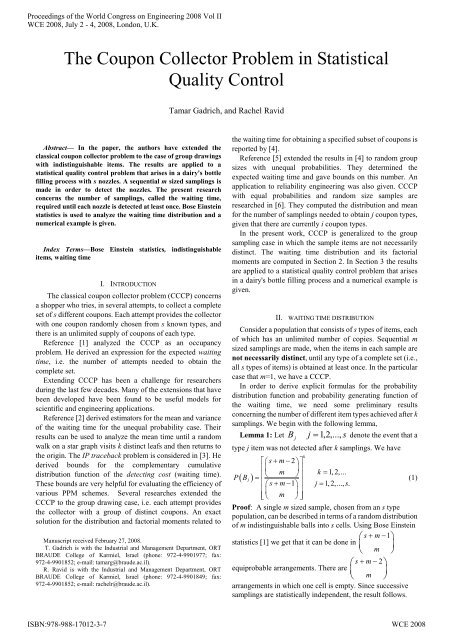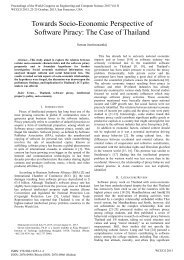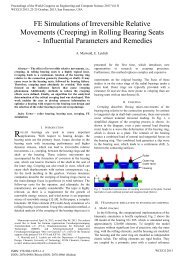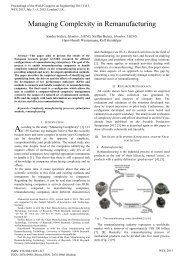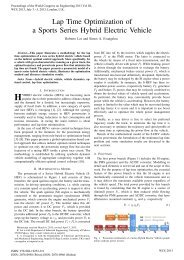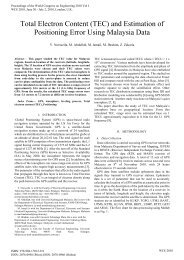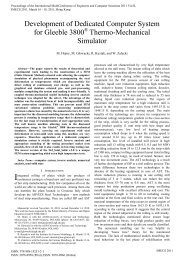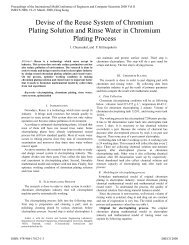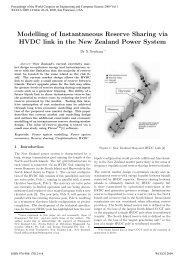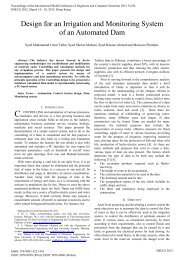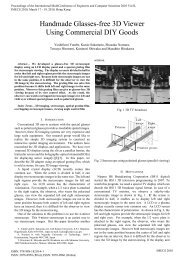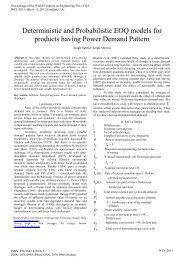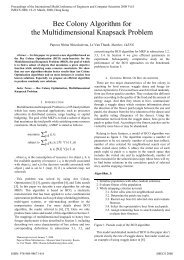The Coupon Collector Problem in Statistical Quality Control
The Coupon Collector Problem in Statistical Quality Control
The Coupon Collector Problem in Statistical Quality Control
Create successful ePaper yourself
Turn your PDF publications into a flip-book with our unique Google optimized e-Paper software.
Proceed<strong>in</strong>gs of the World Congress on Eng<strong>in</strong>eer<strong>in</strong>g 2008 Vol II<br />
WCE 2008, July 2 - 4, 2008, London, U.K.<br />
<strong>The</strong> <strong>Coupon</strong> <strong>Collector</strong> <strong>Problem</strong> <strong>in</strong> <strong>Statistical</strong><br />
<strong>Quality</strong> <strong>Control</strong><br />
Tamar Gadrich, and Rachel Ravid<br />
<br />
Abstract— In the paper, the authors have extended the<br />
classical coupon collector problem to the case of group draw<strong>in</strong>gs<br />
with <strong>in</strong>dist<strong>in</strong>guishable items. <strong>The</strong> results are applied to a<br />
statistical quality control problem that arises <strong>in</strong> a dairy's bottle<br />
fill<strong>in</strong>g process with s nozzles. A sequential m sized sampl<strong>in</strong>gs is<br />
made <strong>in</strong> order to detect the nozzles. <strong>The</strong> present research<br />
concerns the number of sampl<strong>in</strong>gs, called the wait<strong>in</strong>g time,<br />
required until each nozzle is detected at least once. Bose E<strong>in</strong>ste<strong>in</strong><br />
statistics is used to analyze the wait<strong>in</strong>g time distribution and a<br />
numerical example is given.<br />
Index Terms—Bose E<strong>in</strong>ste<strong>in</strong> statistics, <strong>in</strong>dist<strong>in</strong>guishable<br />
items, wait<strong>in</strong>g time<br />
I. INTRODUCTION<br />
<strong>The</strong> classical coupon collector problem (CCCP) concerns<br />
a shopper who tries, <strong>in</strong> several attempts, to collect a complete<br />
set of s different coupons. Each attempt provides the collector<br />
with one coupon randomly chosen from s known types, and<br />
there is an unlimited supply of coupons of each type.<br />
Reference [1] analyzed the CCCP as an occupancy<br />
problem. He derived an expression for the expected wait<strong>in</strong>g<br />
time, i.e. the number of attempts needed to obta<strong>in</strong> the<br />
complete set.<br />
Extend<strong>in</strong>g CCCP has been a challenge for researchers<br />
dur<strong>in</strong>g the last few decades. Many of the extensions that have<br />
been developed have been found to be useful models for<br />
scientific and eng<strong>in</strong>eer<strong>in</strong>g applications.<br />
Reference [2] derived estimators for the mean and variance<br />
of the wait<strong>in</strong>g time for the unequal probability case. <strong>The</strong>ir<br />
results can be used to analyze the mean time until a random<br />
walk on a star graph visits k dist<strong>in</strong>ct leafs and then returns to<br />
the orig<strong>in</strong>. <strong>The</strong> IP traceback problem is considered <strong>in</strong> [3]. He<br />
derived bounds for the complementary cumulative<br />
distribution function of the detect<strong>in</strong>g cost (wait<strong>in</strong>g time).<br />
<strong>The</strong>se bounds are very helpful for evaluat<strong>in</strong>g the efficiency of<br />
various PPM schemes. Several researches extended the<br />
CCCP to the group draw<strong>in</strong>g case, i.e. each attempt provides<br />
the collector with a group of dist<strong>in</strong>ct coupons. An exact<br />
solution for the distribution and factorial moments related to<br />
Manuscript received February 27, 2008.<br />
T. Gadrich is with the Industrial and Management Department, ORT<br />
BRAUDE College of Karmiel, Israel (phone: 972-4-9901977; fax:<br />
972-4-9901852; e-mail: tamarg@braude.ac.il).<br />
R. Ravid is with the Industrial and Management Department, ORT<br />
BRAUDE College of Karmiel, Israel (phone: 972-4-9901849; fax:<br />
972-4-9901852; e-mail: rachelr@braude.ac.il).<br />
the wait<strong>in</strong>g time for obta<strong>in</strong><strong>in</strong>g a specified subset of coupons is<br />
reported by [4].<br />
Reference [5] extended the results <strong>in</strong> [4] to random group<br />
sizes with unequal probabilities. <strong>The</strong>y determ<strong>in</strong>ed the<br />
expected wait<strong>in</strong>g time and gave bounds on this number. An<br />
application to reliability eng<strong>in</strong>eer<strong>in</strong>g was also given. CCCP<br />
with equal probabilities and random size samples are<br />
researched <strong>in</strong> [6]. <strong>The</strong>y computed the distribution and mean<br />
for the number of sampl<strong>in</strong>gs needed to obta<strong>in</strong> j coupon types,<br />
given that there are currently i coupon types.<br />
In the present work, CCCP is generalized to the group<br />
sampl<strong>in</strong>g case <strong>in</strong> which the sample items are not necessarily<br />
dist<strong>in</strong>ct. <strong>The</strong> wait<strong>in</strong>g time distribution and its factorial<br />
moments are computed <strong>in</strong> Section 2. In Section 3 the results<br />
are applied to a statistical quality control problem that arises<br />
<strong>in</strong> a dairy's bottle fill<strong>in</strong>g process and a numerical example is<br />
given.<br />
II. WAITING TIME DISTRIBUTION<br />
Consider a population that consists of s types of items, each<br />
of which has an unlimited number of copies. Sequential m<br />
sized sampl<strong>in</strong>gs are made, when the items <strong>in</strong> each sample are<br />
not necessarily dist<strong>in</strong>ct, until any type of a complete set (i.e.,<br />
all s types of items) is obta<strong>in</strong>ed at least once. In the particular<br />
case that m=1, we have a CCCP.<br />
In order to derive explicit formulas for the probability<br />
distribution function and probability generat<strong>in</strong>g function of<br />
the wait<strong>in</strong>g time, we need some prelim<strong>in</strong>ary results<br />
concern<strong>in</strong>g the number of different item types achieved after k<br />
sampl<strong>in</strong>gs. We beg<strong>in</strong> with the follow<strong>in</strong>g lemma,<br />
Lemma 1: Let B j<br />
j 1,2,...,<br />
s denote the event that a<br />
type j item was not detected after k sampl<strong>in</strong>gs. We have<br />
k<br />
s m 2<br />
<br />
<br />
m k 1,2,...<br />
PBj<br />
<br />
<br />
(1)<br />
sm1<br />
j 1,2,..., s.<br />
<br />
<br />
<br />
m <br />
Proof: A s<strong>in</strong>gle m sized sample, chosen from an s type<br />
population, can be described <strong>in</strong> terms of a random distribution<br />
of m <strong>in</strong>dist<strong>in</strong>guishable balls <strong>in</strong>to s cells. Us<strong>in</strong>g Bose E<strong>in</strong>ste<strong>in</strong><br />
sm1<br />
statistics [1] we get that it can be done <strong>in</strong> <br />
m <br />
sm2<br />
equiprobable arrangements. <strong>The</strong>re are <br />
m <br />
arrangements <strong>in</strong> which one cell is empty. S<strong>in</strong>ce successive<br />
sampl<strong>in</strong>gs are statistically <strong>in</strong>dependent, the result follows.<br />
ISBN:978-988-17012-3-7 WCE 2008
Proceed<strong>in</strong>gs of the World Congress on Eng<strong>in</strong>eer<strong>in</strong>g 2008 Vol II<br />
WCE 2008, July 2 - 4, 2008, London, U.K.<br />
Def<strong>in</strong>e the random variable X<br />
k<br />
to be the number of different<br />
item types achieved after k sampl<strong>in</strong>gs;<br />
<strong>The</strong>orem 1: <strong>The</strong> distribution of X k<br />
k 1 is given for<br />
every n (n=1,2,…,s) by:<br />
n<br />
m1<br />
<br />
n1<br />
s n <br />
<br />
m <br />
k n 1<br />
<br />
<br />
<br />
n s m 1<br />
0<br />
<br />
<br />
<br />
m <br />
<br />
P X<br />
P Xk<br />
n 1 1<br />
(2)<br />
k<br />
<br />
m<br />
1<br />
n1<br />
s s<br />
1<br />
<br />
n<br />
<br />
m <br />
<br />
(3)<br />
s m 1<br />
0<br />
<br />
s<br />
n <br />
<br />
<br />
m <br />
<br />
Proof: Def<strong>in</strong>e A j<br />
,..., <br />
( n )<br />
<br />
1<br />
j n<br />
to be a fixed n sized<br />
subset of the complete type set. <strong>The</strong> probability that these<br />
item types will be obta<strong>in</strong>ed after k sampl<strong>in</strong>gs equals:<br />
<br />
n<br />
n<br />
j<br />
<br />
j<br />
<br />
1 1<br />
<br />
<br />
.<br />
P B 1P B<br />
Us<strong>in</strong>g the <strong>in</strong>clusion-exclusion formula, the probability that<br />
at least one of the item types <strong>in</strong> A<br />
(n)<br />
will not be obta<strong>in</strong>ed <strong>in</strong> k<br />
sampl<strong>in</strong>gs is:<br />
P<br />
mn<br />
1<br />
n<br />
n 1<br />
n <br />
<br />
1<br />
m<br />
<br />
<br />
<br />
Bj<br />
1<br />
<br />
<br />
s m 1<br />
1<br />
1<br />
<br />
<br />
<br />
m <br />
<br />
Obviously,<br />
<br />
n<br />
m1<br />
<br />
<br />
n 1<br />
s n<br />
<br />
<br />
<br />
<br />
m<br />
<br />
<br />
k<br />
n 1<br />
<br />
<br />
n<br />
s m 1<br />
0 <br />
<br />
<br />
m <br />
<br />
P X<br />
<br />
.<br />
Equation (3) is derived from (2) with the aid of Lemma 2 <strong>in</strong><br />
[4]. <strong>The</strong> cumulative distribution function is<br />
k<br />
k<br />
k<br />
.<br />
k k <br />
P X n P X i <br />
s<br />
<br />
<strong>in</strong><br />
k<br />
s<br />
i<br />
s m 1 s i m i 1<br />
<br />
<br />
1<br />
<br />
m <strong>in</strong> i 0<br />
<br />
m <br />
k<br />
k<br />
s<br />
s<br />
s m 1 m 1<br />
s i<br />
<br />
i <br />
1 1<br />
<br />
m 0 m imax <br />
, n<br />
i <br />
<br />
<br />
k<br />
k<br />
s<br />
s<br />
s m 1 s m 1<br />
s<br />
<br />
<br />
<br />
i <br />
1 1<br />
<br />
m 0 m imax <br />
, n<br />
i <br />
<br />
k<br />
n1<br />
s m 1 s s 1 m 1<br />
n<br />
<br />
1<br />
<br />
m 0<br />
<br />
s n m <br />
k<br />
k<br />
s m 1 s m 1<br />
s <br />
<br />
m m <br />
s<br />
1 1 ,<br />
which derived (3).<br />
Corollary 1: <strong>The</strong> expected number of dist<strong>in</strong>ct item types<br />
that are achieved after a series of k 1 sampl<strong>in</strong>gs is given by<br />
k<br />
ms2<br />
<br />
<br />
<br />
m <br />
E X k <br />
<br />
s 1 k 1, 2,...<br />
ms1<br />
<br />
<br />
<br />
<br />
<br />
m <br />
<br />
<br />
Proof: For 1 j s def<strong>in</strong>e<br />
X<br />
0<br />
<br />
I <br />
j <br />
<br />
1<br />
item j has not been<br />
obta<strong>in</strong>ed dur<strong>in</strong>g k sampl<strong>in</strong>gs<br />
otherwise<br />
One can easily see that:<br />
k<br />
s<br />
I<br />
j 1<br />
Clearly,<br />
j<br />
s m 2<br />
<br />
<br />
m<br />
PI j 1 E I j PBj<br />
1 <br />
<br />
.<br />
sm1<br />
<br />
<br />
<br />
<br />
m <br />
Us<strong>in</strong>g the additive property of expectation, we get:<br />
k<br />
sm2<br />
<br />
<br />
<br />
<br />
<br />
j<br />
j 1<br />
<br />
<br />
<br />
<br />
<br />
m <br />
<br />
<br />
s<br />
m<br />
E X k<br />
E I s 1<br />
<br />
sm1<br />
.<br />
We now return to our ma<strong>in</strong> purpose: determ<strong>in</strong><strong>in</strong>g the<br />
wait<strong>in</strong>g time. Let Z be the number of sampl<strong>in</strong>gs needed<br />
n<br />
until one collects at least n item types from the complete set.<br />
k<br />
<br />
k<br />
k<br />
<br />
(4)<br />
ISBN:978-988-17012-3-7 WCE 2008
Proceed<strong>in</strong>gs of the World Congress on Eng<strong>in</strong>eer<strong>in</strong>g 2008 Vol II<br />
WCE 2008, July 2 - 4, 2008, London, U.K.<br />
<strong>The</strong>orem 2: <strong>The</strong> distribution of<br />
(for every k 1) by:<br />
<br />
P Z<br />
n<br />
k<br />
<br />
<br />
Z n<br />
1 n s is given<br />
n1<br />
s s 1<br />
n<br />
1<br />
<br />
1<br />
<br />
<br />
(5)<br />
0<br />
<br />
s<br />
n <br />
<br />
s m 1 <br />
m 1 <br />
m 1<br />
<br />
m m<br />
<br />
m<br />
<br />
<br />
<br />
<br />
<br />
s m 1 s m 1<br />
<br />
<br />
k 1<br />
m m <br />
Moreover, the probability generat<strong>in</strong>g function (p.g.f.) of<br />
Z is given by<br />
n<br />
G<br />
Zn<br />
<br />
<br />
<br />
n 1 1<br />
1<br />
1<br />
n <br />
s s<br />
<br />
<br />
<br />
(6)<br />
<br />
0<br />
<br />
s<br />
n <br />
s m 1 <br />
m 1<br />
<br />
<br />
m m s m 1 <br />
m 1<br />
<br />
<br />
m m <br />
Proof: <strong>The</strong> probability distribution function of Z n can be<br />
obta<strong>in</strong>ed from (3) us<strong>in</strong>g the follow<strong>in</strong>g relation:<br />
P Z k P X n P X n .<br />
G<br />
n k k 1<br />
<br />
<strong>The</strong> p.g.f. of<br />
Z<br />
n<br />
Z<br />
E<br />
<br />
Z n is def<strong>in</strong>ed as:<br />
n<br />
<br />
n1<br />
s s 1<br />
k<br />
n<br />
1<br />
<br />
<br />
1<br />
<br />
<br />
k 1 0<br />
<br />
s<br />
n <br />
(7)<br />
<br />
s m 1 <br />
m 1 <br />
m 1<br />
<br />
m m<br />
<br />
m<br />
<br />
<br />
<br />
<br />
<br />
s m 1 s m 1<br />
<br />
<br />
m m <br />
k 1<br />
<br />
m<br />
1<br />
<br />
m<br />
Equation (6) follows (7) <strong>in</strong> the case that<br />
<br />
is<br />
s<br />
m1<br />
<br />
m <br />
less than 1.<br />
Corollary 2: <strong>The</strong> p-factorial moments p N<br />
of Z n<br />
are<br />
given by:<br />
<br />
1 ... 1<br />
E Z Z Z p <br />
n n n<br />
n1<br />
s s<br />
1<br />
n<br />
1<br />
p! 1<br />
<br />
<br />
0<br />
s<br />
n <br />
<br />
s m 1 <br />
m 1<br />
<br />
m m <br />
<br />
p1<br />
s m 1 <br />
m 1<br />
<br />
<br />
<br />
m m <br />
<br />
<br />
<br />
p<br />
Proof: <strong>The</strong> result <strong>in</strong> (8) follows (7) by deriv<strong>in</strong>g the p.g.f. of<br />
.<br />
Z accord<strong>in</strong>g to , p times and substitut<strong>in</strong>g 1<br />
n<br />
Corollary 3: <strong>The</strong> expectation and the variance of the<br />
wait<strong>in</strong>g time until we achieve the complete set are given by:<br />
E Z <br />
<br />
s1<br />
<br />
0<br />
<br />
<br />
E Z<br />
s<br />
<br />
<br />
1<br />
s<br />
s1<br />
<br />
s<br />
1<br />
s m 1<br />
<br />
s<br />
m <br />
<br />
<br />
s m 1 <br />
m 1<br />
<br />
m m <br />
<br />
<br />
<br />
(8)<br />
(9)<br />
s<br />
1<br />
<br />
<br />
(10)<br />
2! 1<br />
0<br />
Z 1<br />
<br />
s<br />
s<br />
<br />
<br />
<br />
<br />
s m 1 <br />
m 1<br />
<br />
m m <br />
<br />
s m 1 <br />
m 1<br />
<br />
<br />
<br />
m m <br />
<br />
<br />
2<br />
s s s s s <br />
VAR Z E Z Z 1 E Z E Z (11)<br />
Proof: Formulas (9) and (10) are derived from (8) by<br />
substitut<strong>in</strong>g p=1 and p=2, respectively; and n=s.<br />
III. NUMERICAL EXAMPLE<br />
<strong>The</strong> model described <strong>in</strong> Section II has a direct application<br />
to a statistical quality control problem. Consider a dairy's<br />
bottle fill<strong>in</strong>g process consist<strong>in</strong>g of a 24-nozzle mach<strong>in</strong>e. After<br />
the bottles are filled with milk, they are gathered <strong>in</strong> a<br />
collection area. Each hour a random sample of five bottles is<br />
drawn from the collection area and tested <strong>in</strong> order to control<br />
the fill<strong>in</strong>g process. <strong>The</strong>re is no mark<strong>in</strong>g on a bottle <strong>in</strong>dicat<strong>in</strong>g<br />
which nozzle filled it. <strong>The</strong> quality eng<strong>in</strong>eer wants to know,<br />
after how many hours on the average, bottles filled by any one<br />
of the nozzles will be tested.<br />
Us<strong>in</strong>g the notations of Section II, the 24 nozzles form a<br />
2<br />
ISBN:978-988-17012-3-7 WCE 2008
Expectation<br />
Zs<br />
Proceed<strong>in</strong>gs of the World Congress on Eng<strong>in</strong>eer<strong>in</strong>g 2008 Vol II<br />
WCE 2008, July 2 - 4, 2008, London, U.K.<br />
complete set of s types (s=24). An hourly random draw<strong>in</strong>g of<br />
five bottles def<strong>in</strong>es the sample size m=5. S<strong>in</strong>ce the bottles are<br />
not marked, the model that assumes that the items <strong>in</strong> each<br />
sample are not necessarily dist<strong>in</strong>ct is suitable here. Us<strong>in</strong>g (2),<br />
the probability distribution function of Z<br />
24<br />
is shown <strong>in</strong> Fig. 1<br />
as a function of k – the number of hourly draw<strong>in</strong>gs that are<br />
done <strong>in</strong> order to test all the nozzles.<br />
0.08<br />
0.07<br />
0.06<br />
0.05<br />
0.04<br />
0.03<br />
0.02<br />
0.01<br />
0<br />
0 5 10 15 20 25 30 35 40 45 50<br />
Time (hours)<br />
Fig. 1. Wait<strong>in</strong>g time probability distribution function for<br />
k=1,2,…,50 (s=24, m=5)<br />
Us<strong>in</strong>g (9), the expectation of Z<br />
24<br />
is shown <strong>in</strong> Fig. 2 as a<br />
function of m – the sample size. This can be useful for the<br />
quality control eng<strong>in</strong>eer. If there is any constra<strong>in</strong>t on how<br />
many hourly sampl<strong>in</strong>gs he can draw, the analyst will easily<br />
f<strong>in</strong>d the required sample size for detect<strong>in</strong>g the complete set.<br />
100<br />
90<br />
80<br />
70<br />
60<br />
50<br />
40<br />
30<br />
20<br />
10<br />
0<br />
0 5 10 15 20 25<br />
Sample Size<br />
Fig. 2. Wait<strong>in</strong>g time expectation as a function of the<br />
sample size m (s=24)<br />
In Table 1, for s=24, the expectations and standard<br />
deviations of the wait<strong>in</strong>g time as a function of the sample size<br />
(i.e., as a function of m) are given for the follow<strong>in</strong>g two cases:<br />
1. In each sampl<strong>in</strong>g a set of m different items is drawn. <strong>The</strong><br />
factorial moments related to the wait<strong>in</strong>g, <strong>in</strong> this case, were<br />
obta<strong>in</strong>ed <strong>in</strong> [4] by:<br />
<br />
p1<br />
1 ... 1<br />
E Z Z Z p <br />
n n n<br />
s n1<br />
s s j 1<br />
p! 1<br />
m <br />
j0<br />
j s n <br />
<br />
nj1<br />
(12)<br />
j s j <br />
<br />
<br />
<br />
m m m<br />
<br />
<br />
p<br />
<strong>The</strong> expectation and the standard deviation follow from<br />
(12).<br />
2. In each sampl<strong>in</strong>g, a group of m items is drawn, but the<br />
items are not necessarily dist<strong>in</strong>ct. <strong>The</strong> expectation and the<br />
standard deviation can be computed us<strong>in</strong>g (9) and (11),<br />
respectively.<br />
Substitut<strong>in</strong>g m=1, <strong>in</strong> (8)-(12) yields the known results for<br />
the CCCP when s=24. On average, one needs around 91<br />
sampl<strong>in</strong>gs <strong>in</strong> order to be sure of detect<strong>in</strong>g all 24 different<br />
types.<br />
In the diary problem when m=5; the calculations yield that<br />
on average, after 20 hours all the nozzles will have been<br />
exam<strong>in</strong>ed.<br />
Table 1. Expectation and standard deviation of the wait<strong>in</strong>g<br />
time s=24<br />
Dist<strong>in</strong>ct items Indist<strong>in</strong>guishable<br />
items<br />
Draw<strong>in</strong><br />
g group<br />
Expecta- S.D. Expecta- S.D. size<br />
tion<br />
tion<br />
90.6230 28.8678 90.6230 28.8678 1<br />
44.5973 14.1120 46.4861 14.7463 2<br />
29.2456 9.1909 31.7659 10.0372 3<br />
21.5619 6.7285 24.4002 7.6813 4<br />
16.9449 5.2494 19.9765 6.2667 5<br />
13.8609 4.2618 17.0240 5.3228 6<br />
11.6523 3.5549 14.9123 4.6480 7<br />
9.9905 3.0235 13.3263 4.1413 8<br />
8.6928 2.6088 12.0908 3.7468 9<br />
7.6494 2.2758 11.1008 3.4308 10<br />
6.7906 2.0019 10.2893 3.1719 11<br />
6.0696 1.7721 9.6118 2.9558 12<br />
5.4538 1.5769 9.0374 2.7727 13<br />
4.9195 1.4085 8.5441 2.6156 14<br />
4.4509 1.2589 8.1157 2.4791 15<br />
4.0363 1.1229 7.7400 2.3596 16<br />
3.6632 1.0034 7.4077 2.2539 17<br />
3.3172 0.9058 7.1118 2.1598 18<br />
2.9872 0.8230 6.8464 2.0755 19<br />
2.6745 0.7305 6.6069 1.9995 20<br />
2.3961 0.6008 6.3898 1.9306 21<br />
2.1782 0.4236 6.1919 1.8679 22<br />
2.0435 0.2130 6.0108 1.8105 23<br />
IV. CONCLUSIONS<br />
A well known problem, called the CCCP, is extended to the<br />
case of group sampl<strong>in</strong>g with <strong>in</strong>dist<strong>in</strong>guishable items, us<strong>in</strong>g an<br />
<br />
ISBN:978-988-17012-3-7 WCE 2008
Proceed<strong>in</strong>gs of the World Congress on Eng<strong>in</strong>eer<strong>in</strong>g 2008 Vol II<br />
WCE 2008, July 2 - 4, 2008, London, U.K.<br />
occupancy model. Clearly, group draw<strong>in</strong>gs help to reduce the<br />
expected number of sampl<strong>in</strong>gs required <strong>in</strong> order to detect the<br />
complete set. <strong>The</strong> probability generat<strong>in</strong>g function has been<br />
developed for comput<strong>in</strong>g the expectation and standard<br />
deviation of the wait<strong>in</strong>g time. <strong>Quality</strong> eng<strong>in</strong>eers may f<strong>in</strong>d the<br />
given expressions useful for controll<strong>in</strong>g processes such as the<br />
bottle fill<strong>in</strong>g process described <strong>in</strong> this paper.<br />
REFERENCES<br />
[1] W. Feller, An Introduction to Probability <strong>The</strong>ory and Its Application,<br />
Wiley: New York, Third Edition, 1970, ch. 4.<br />
[2] E. Pekoz and S. M. Ross, Applied Probability and Stochastic<br />
Processes, vol. 19, J. S. Shanthikumar and U. Sumita, Eds. Boston:<br />
Kluwer, 1999, pp. 83–94.<br />
[3] S. Shioda, “Some upper and lower bounds on the coupon collector<br />
problem,” Journal of Computational and Applied Mathematics, vol.<br />
200, 2007, pp. 154–167,<br />
[4] W. Stadje, “<strong>The</strong> collector’s problem with group draw<strong>in</strong>gs,” Advances<br />
<strong>in</strong> Applied Probability, vol. 22, 1990, pp. 866–882.<br />
[5] I. Adler and S. M. Ross, “<strong>The</strong> coupon subset collection problem,”<br />
Journal of Applied Probability, vol. 38, 2001, pp. 737–746.<br />
[6] J. E. Kobza, S. H. Jacobson, and D. E. Vaughan, “A survey of the<br />
coupon collector’s problem with random sample sizes,” Methodology<br />
and Comput<strong>in</strong>g <strong>in</strong> Applied Probability, vol. 9(4), 2007, pp. 573–584.<br />
ISBN:978-988-17012-3-7 WCE 2008


